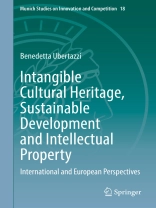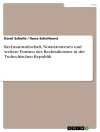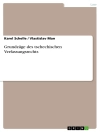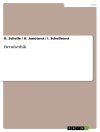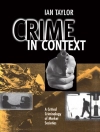This book critically analyses the relationships between intangible cultural heritage (ICH), sustainable development and intellectual property rights (IPRs). The author argues that although the use of IPRs to safeguard ICH presents challenges and has impeded sustainable development in some cases, the adoption of these rights on ICH also presents opportunities and, fundamentally, is not contrary to the spirit of the UNESCO Convention for the Safeguarding of the Intangible Cultural Heritage (UNESCO 2003 Convention). The adoption of IPRs on ICH can form an important part of the development of sustainable safeguarding plans capable of benefitting the communities, groups and individuals (CGIs) that create, maintain and transmit such heritage. The book provides a nuanced analysis of the relationship between intellectual property (IP) law and ICH as well as examining the role of IPRs in safeguarding ICH through the lens of sustainable development. It analyses the relationship between IP law and ICH from environmental, social and economic perspectives. These perspectives allow a thorough evaluation of both the positive effects and potential pitfalls of adopting IPRs to safeguard ICH. The book addresses deeper structural matters that refer back to the safeguarding of social and environmental processes underlying ICH.
Daftar Isi
1: Introduction
The introduction provides a sharp, concise introduction to the general aims and
argument of the book, in addition to setting out the structure through which the
book will engage with these aims.
2: Intangible Cultural Heritage
Chapter 2 focuses on the first major part of this book, namely ICH. It lays the
groundwork for some of the broader theoretical themes that run through the book,
namely: defining the nature of ICH, principally through the domains of ICH set
out in the UNESCO 2003 Convention; the notion of safeguarding ICH; the role of
communities, groups and individuals within the framework of the 2003 Convention
and finally the instruments, objects, artefacts and cultural spaces associated with
ICH.
2.1 The Definition and Practice of Intangible Cultural Heritage
2.2 Safeguarding
2.3 The Subjective Component of Intangible Cultural Heritage: Communities,
Groups and Individuals
2.4 The Objective and Spatial Components of Intangible Cultural Heritage:
Instruments, Objects, Artefacts and Cultural Spaces
3: Sustainable Development and Intangible Cultural Heritage
Chapter 3 focuses on the second major part of this book, namely sustainable
development. Specifically, sustainable development can be of an economic, social
and environmental character, inclusive of human rights, facilitative of mutual
respect among communities and intended to better safeguard ICH. The Chapter
examines how culture and ICH in particular are linked to sustainable development
as illustrated in the 2003 UNESCO Convention, its Operational Directives and its
Overall Results Framework. The Chapter analyses the role of ICH as a strategic
resource to enable inclusive sustainable development and therefore participation
and inclusive governance. The chapter also introduces ICH as a relevant tool to
enable environmentally sustainable development, as well as inclusive economic
development. In addressing inclusive economic development, chapter 3 lays
the foundation for subsequent chapters to explore the relationship between ICH
and IPRs, intended as a mechanism to foster valorization and promotion of ICH,
towards its viability and vitality for the benefit of the communities concerned. Peace
and security, as a requirement that is essential for sustainable development, and
a key component of UNESCO’s mission, is also addressed in the chapter. Finally,
chapter 3 concludes with analysis of the Covid-19 pandemic as a case study on the
relationship between ICH and sustainable development, exhibiting the importance
of community-based resilience, with indigenous and local communities at the
forefront of this process.
3.1 The Definition and Practice of Sustainable Development in the context of
Intangible Cultural Heritage
3.2 Inclusive Social Development: Participation and Inclusive Governance
3.3 Environmental sustainability
3.4 Inclusive Economic Development and Commercialisation
3.5 Peace and Security
3.6 Covid-19: A case study
4: Intellectual Property Rights and Intangible Cultural Heritage
Chapter 4 focuses on the third major part of this book, namely IPRs. It provides
analysis of different IPRs, including sui generis IPRs, and the strengths and
weaknesses of such rights as mechanisms capable of safeguarding ICH. The
chapter argues that while IPRs can be insufficient to protect ICH, and can even
reinforce misappropriation of such heritage, there are circumstances in which
IPRs are valuable not only in their capacity to empower indigenous and local
communities themselves, but also in their capacity to work alongside other
safeguarding mechanisms that can offer different protections.
4.1 Intangible Cultural Heritage, Intellectual Property Rights and Territorial
Enforcement
4.2 Copyright and Neighbouring Rights
4.3 Patents, Industrial Designs
4.4 Know-how, Trade Secrets, Databases and Contracts
4.5 Individual, Collective, Certification Trade Marks
4.6 Geographical Indications, Protected Designation of Origin, Traditional
Speciality Guaranteed
4.7 The Limitations of Intellectual Property Rights as Safeguarding Mechanisms for
Intangible Cultural Heritage
4.8 Sui Generis Intellectual Property Rights and the Relationship between Property
and Heritage
4.9 Intellectual Property Rights May Be Capable of Safeguarding Intangible
Cultural Heritage
5: Intellectual property rights on UNESCO intangible cultural heritage
Chapter 5 analyses the relationship between ICH and IP in practice. It analyses
ICH that has been inscribed in the UNESCO Lists under the UNESCO 2003
Convention and in relation to which the relevant nomination files indicate that the
interested communities have also adopted IPRs as a safeguarding measure for
their ICH. This chapter provides an insight into the different types of IPRs used
by ICH-bearing communities to safeguard their traditional practices. The Chapter
concludes with a consideration of the relationship between the UNESCO 2003
Convention and IPRs as safeguarding measures for ICH.
5.1 Intellectual Property Rights and the Convention
5.2 Copyright: Dikopelo folk music of Bakgatla ba Kgafela in Kgatleng District
(Botswana)
5.3 Copyright and certification trademark: Indonesian Batik
5.4 Patents, Trade Marks, Contractual Clauses and Non-Disclosure Agreements:
Craftsmanship of mechanical watchmaking and art mechanics (France and
Switzerland)
5.5 Collective trademarks: Traditional violin craftsmanship in Cremona (Italy)
5.6 Individual trademark: ‘Mediterranean Diet” (Italy)
5.7 Geographical Indications, Protected Designation of Origin, Traditional
Speciality Guaranteed: Traditional agricultural practice of cultivating the ‘vite ad
alberello’ (head-trained bush vines) of the community of Pantelleria (Italy)
5.8 Intellectual property rights on intangible cultural heritage shall respect the spirit
of the Convention
6: The Relationship between Intangible Cultural Heritage, Sustainable
Development and Intellectual Property Rights
Chapter 6 brings the relationship between ICH, sustainable development and IPRs
to the fore. It provides an analysis of the challenges and opportunities of using
IPRs to achieve social, environmental and economic sustainable development
aims for ICH safeguarding that are articulated by the 2003 UNESCO Convention.
This chapter also addresses the enforcement of IPRs on ICH and concludes with
an analysis of the challenges of the cross-border enforcement of IPRs by the
interested communities.
6.1 Social Sustainable Development: Inclusive Multilevel Governance Systems of
Collective Intellectual Property Rights engaging and empowering Communities
6.2 Environmental Sustainable Development: Community-based Resilience;
Environmental Impacts, Knowledge and Practices Regarding Nature and the
Universe; Resilience to
Natural Disasters and Climate Change and Intellectual Property Rights
6.3 Economic Sustainable Development: Intellectual Property Rights protecting
Intangible Cultural Heritage against Commercialisation Risks
6.4 Consolidation of Litigation for Cross-border Enforcement of Intellectual Property
Rights on Intangible Cultural Heritage
Tentang Penulis
Benedetta Ubertazzi has been a UNESCO Facilitator on the global capacity building programme for the effective implementation of the 2003 Convention for the Safeguarding of the Intangible Cultural Heritage and a capacity builder with the International Academy on UNESCO Designations and Sustainable Development since 2018. She is a tenured Aggregate Professor of European Union Law at the University of Milan-Bicocca, a Jean Monnet Module coordinator (2022-2025), a lecturer for the WIPO-Turin Master of Laws in Intellectual Property and an expert in the WIPO Indigenous and Local Community Women Entrepreneurship Program. She has been a Von Humboldt Foundation Fellow (hosted by the Max Planck Institute for Innovation and Competition) since 2010 and she is a member of the International Law Association Committees for Participation in Global Cultural Heritage Governance (appointed by the chairs) and respectively Intellectual Property and Private International Law. In 2018, she becamea co-evaluator for UNESCO at the Regional Research Centre for Safeguarding Intangible Cultural Heritage in West and Central Asia (UNESCO Category 2 Centre) based in Tehran. She has served as a legal expert for the Italian Ministry of Foreign Affairs and International Cooperation at multinational negotiations of the UNESCO Intergovernmental Committee for the Safeguarding of Intangible Cultural Heritage since 2010. She has been a co-facilitator of capacity-building for sustainable development plans for several communities around the world and she is a legal expert for many elements, including
Traditional violin craftsmanship in Cremona (UNESCO Representative List 2012); and
Falconry, a living human heritage (UNESCO Representative List 20216), among others. She is a member of the steering committees for the inscription of
Tocatì, programme for the safeguarding of traditional games and sports and respectively
Alpine Food Heritage: Knowledge, knowledge, skills, practices and values of alpine communities (both in the nomination phase for the UNESCO Register of Good Safeguarding Practices). Between 2018–2021, she was a member of the ‘HIPAMS Heritage Sensitive Intellectual Property and Marketing Strategies: India’ project, which was supported and facilitated by the British Library Sustainable Development Programme, Coventry University and communities in West Bengal, India.
